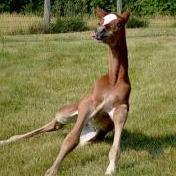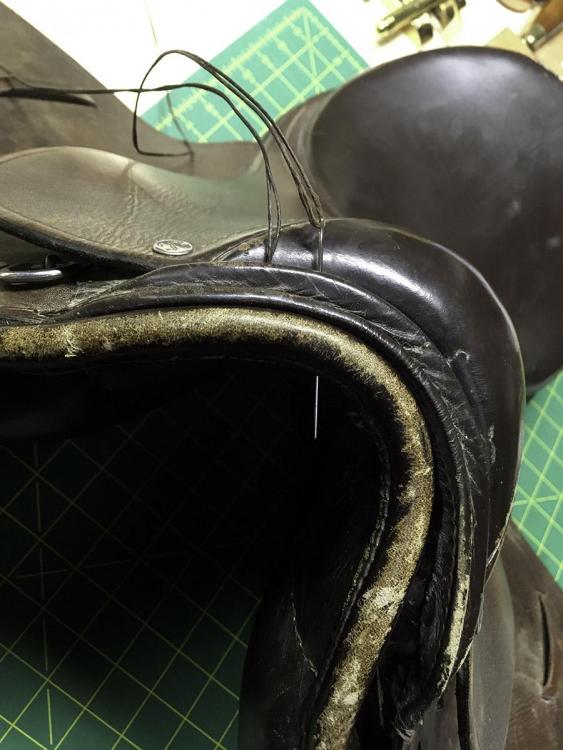-
Posts
1,282 -
Joined
-
Last visited
Content Type
Profiles
Forums
Events
Blogs
Gallery
Everything posted by TomE
-
Handsome piece of work, and so nicely constructed. The colors, the shape, the details of the handle and zipper closure. It's all first rate.
-
Yes, that makes sense. Need a sweatshop in the USA to make good for the Danish market. This Youtube channel is where I learned to tie halters and lead ropes. I think there are 3 videos for making a halter, 2 videos for the eye splice, and a video for the butt splice.
-
Good luck with your new business, Jonas. Look forward to following what you do. I like the tack holders. Ideas for other products: name plates for show stalls with farm name/logo/contact number and place for horse name (chalk/eraseable marker/taped on), quality lead ropes in various lengths (eye splice for snap, butt slice on end), rope halters for training young horses, leather side reins and surcingles. We use quite a few hay nets for ponies and replace them when a hole is torn. Not sure if repairing these nets is profitable. Keep up the good work!
-
Lots of different treatments for smoothing the flesh side. Typically involves a glass slicker to apply a wax or adhesive. I use this water-based adhesive when I split bridle leather, in order to replace the moss-back (pasted) finish. It creates a smooth, flexible surface that is sealed.
-
Great job of repairing the awl. I typically sharpen the point of the awl and only strop the remainder. I think the idea is to pierce the leather with the cutting edges then stretch the hole a bit as the awl is advanced. The hole then relaxes around the thread to make a tidy looking stitch. I like the gradual taper you put on the point. Osborne awl blades have a stubby point that I modify.
- 16 replies
-
- vintage tool
- awl
-
(and 3 more)
Tagged with:
-
Great experiment and lucky dogs! I bought a couple of 1 oz tins of mutton tallow (McQueen's from the Anita Baker Co) for more than I should have paid. Planning to make a leather strop with tallow and carborundum powder but haven't gotten around to trying it. Think I'll find a friend with sheep and try your recipe. Would be interesting to compare this dressing to Effax Leder Balsam and other pricey conditioners.
-

Best places to get the finest Veg Tan shoulder (UK)
TomE replied to cordwainerbec's topic in Leatherwork Conversation
If you fancy black or shades of brown, bridle leather has a nice finish and a smooth pasted back (moss-back). It is veg tanned leather stuffed with fats and waxes. Sedgwick bridle leather seems to be a favorite in the UK. Available from Abbey England and other shops. -
This little round knife has been a handy addition for cutting and skiving in tight places. It seems to hold an edge. https://www.abbeyengland.com/abbey-round-knife-68mm-fs0480
-
I’ve seen this wear pattern on stirrup leathers with rotted linen thread. The thread on the surface is lost but the holes contain plugs of thread. Haven’t seen it turn black but I haven’t worked on pieces that were recolored.
-
Thank you! Still giving them away to people who give feedback on fit and function. Perhaps I will complete my apprenticeship in 2023 and make a business out of this hobby.
-
Thank you for your kind remarks. It is hand stitching. I too am curious what type of machine is used for commercially available bridles and reins. Can't compete with them on price.
-
I used an Arkansas oil stone to shape and sharpen a 3/4" English point punch last night. Mainly pushing strokes on a medium and fine stone, then stropped using green compound. Took over an hour but I wanted to go slow and keep the cutting edge flat. The luxury of being a hobbyist. I am using the punch to cut a taper on a strap and its much improved. The dull punch was drifting towards the edge of the strap instead of punching straight down.
-

First Leather Project
TomE replied to ChipperBags's topic in Purses, Wallets, Belts and Miscellaneous Pocket Items
Good job! Not something I am able to make. I bet she likes it. -

Finished the suspenders finally!
TomE replied to YinTx's topic in Clothing, Jackets, Vests and Chaps
Handsome suspenders with lots of stitching! The trigger snaps are tack and harness hardware. Batz Corp sells them in brass (5103B, 5105B) and stainless steel (5103SS, 5105SS) in addition to zinc diecast. -
Nicely done! Craftsmanship and kindness are a winning combination.
-
Stohlman used thin plywood plates tacked on with leather strips. Gives flexibility for holding odd-shaped projects. I keep collection of leather blocks of different thicknesses to shim the project on either end of the clamp when needed.
-
This is a Weaver stitching horse with modified jaws. The notched aluminum plates resemble a Stohlman design for sewing rounds ("The Art of Hand Sewing Leather"). I sew a lot of straps and can use the center section like regular jaws, or clamp the strap with the raised sections on the ends. That is especially handy for sewing a fixed loop on the buckle turn of a narrow strap. I can clamp the buckle at one end and the strap at the other, then sew the fixed loop in the gap between the ends. Same idea for sewing rounds, although I do most of them on a machine then shape them in a rein rounder.
-
These are 30 in. grips on reins that are 55-60 in. long, for Warmblood jumpers. I haven't replaced grips, only made new reins.
-

English Saddle - Attaching Front of Panel
TomE replied to ShellCordovanFan's topic in Saddle Construction
Sorry to be late to the party. The panel is secured with a single needle running stitch known as a pop stitch. The awl and needle are angled to create ~1/4 inch stitches spaced about 1 inch apart. For the repair, it is best to reuse the old holes without using an awl. I use 0.040" waxed polyester thread from Maine Thread Company, doubled up, for this job. I find it helpful to use a second needle to probe each hole from the opposite direction that I'm pushing the needle and thread. The probe pushes through one of the layers and helps me to get the 2 layers lined up as I push through with the needle and thread. The link you mentioned says to begin by knotting the end of the thread and doing a backstitch to secure the end of the thread before continuing with the pop stitch. That should be sufficient to hold everything together if you have the tree and panel properly positioned for the reassembly. Steinke has more information in "Repair Your Own Saddlery and Harness." -
If it takes up water normally then it's probably fine. Can dye a test piece to be sure. A safe bet is to clean the surface with Fiebings Deglazer. I have used Deglazer to prep bridle leather that I dyed with Fiebings Pro black dye. It removed the waxy surface and a bit of brown dye from the bridle leather. The black dyed piece looks and wears like black bridle leather from the tannery.
-
Thanks. I think I spent about 30 min pop stitching each rein. I see it would be better to include a stitch over each end of the cuff to secure the edge. Learn something with each one I make.



